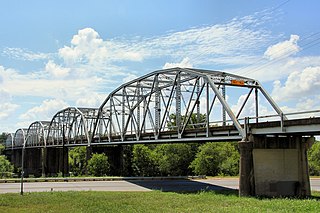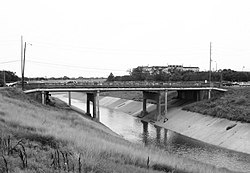
The NRG Astrodome, also known as the Houston Astrodome or simply the Astrodome, is the world's first multi-purpose, domed sports stadium, located in Houston, Texas, United States, with a record attendance of 67,925 set by WWE in 2001.
Genoa is an area in Houston, Texas, United States located about 15 miles (24 km) southeast of Downtown Houston; it was formerly a distinct unincorporated area in Harris County.

Edgar Allan Poe Elementary School is a primary school located at 5100 Hazard Street in Houston, Texas, United States. A part of the Houston Independent School District (HISD), the school, which was built during the 1920s, is located in the Chevy Chase subdivision of the Boulevard Oaks neighborhood west of Rice University. The school, a National Register of Historic Places (NRHP) historic district contributing property of Boulevard Oaks, was named after Edgar Allan Poe.

The Lamar Boulevard Bridge is a historic arch bridge carrying Texas State Highway Loop 343 over Lady Bird Lake in downtown Austin, Texas, United States. The bridge features six open-spandrel concrete arches spanning 659 feet (201 m) and carries tens of thousands of vehicles daily across the lake. Completed in 1942, the Lamar Boulevard Bridge was the second permanent bridge to cross the Colorado River, and one of the last Art Deco-style open-spandrel concrete arch bridges built in Texas. The bridge was named an Austin Landmark in 1993 and added to the National Register of Historic Places in 1994.

The King Iron Bridge & Manufacturing Company was a late-19th-century bridge building company located in Cleveland, Ohio. It was founded by Zenas King (1818–1892) in 1858 and subsequently managed by his sons, James A. King and Harry W. King and then his grandson, Norman C. King, until the mid-1920s. Many of the bridges built by the company were used during America's expansion west in the late 19th century and early 20th century, and some of these bridges are still standing today.

Almeda is an area located along Texas State Highway 288 and the Missouri Pacific Railroad in Southwest Houston, Texas, United States that used to be a distinct unincorporated community in Harris County. Almeda is 11 miles (18 km) from Downtown Houston.

Alfred Charles Finn was an American architect. He started in the profession with no formal training in 1904 as an apprentice for Sanguinet & Staats. He worked in their offices in Dallas, Fort Worth, and Houston. His credits during his tenure residential structures, but firm was a leader in steel-frame construction of skyscrapers.

The Hood County Courthouse Historic District in Granbury, Hood County, Texas encompasses 12 acres of land. The principal building in and the focal point of the district is the historic Hood County Courthouse built in 1890–1891. Other major buildings include the 1885 Hood County Jailhouse, the 1885 First National Bank Building, the 1891 building which formerly housed the Hood County News, the 1893 Aston-Landers Saloon Building, the 1893 Nutt Brothers Building, and the 1886 Granbury Opea House. On June 5, 1974, the district was added to the National Register of Historic Places. The nomination form called it "one of the most complete nineteenth century courthouse squares in Texas." The district is also recognized as a State Antiquities Landmark and includes several Recorded Texas Historic Landmarks.

The Seguin Covered Bridge, also called the Upper Covered Bridge and the Sequin Covered Bridge, is a wooden covered bridge that crosses Lewis Creek in Charlotte, Vermont on Roscoe Road. It was built about 1850, and is a distinctive variant of a Burr arch design. It was listed on the National Register of Historic Places in 1974.

The Montopolis Bridge is a historic Parker through truss bridge in Austin, Texas. It is located in the Montopolis neighborhood where a bicycle and pedestrian walkway crosses the Colorado River in southeastern Travis County. The bridge consists of five 200-foot Parker through truss spans and four 52-foot steel I-beam approach spans resting on reinforced concrete abutments. It was added to the National Register of Historic Places on October 10, 1996.

The Cotton Exchange Building is a historic building located in downtown Houston. Built in 1884, it is listed on the National Register of Historic Places. The Houston Cotton Exchange and Board of Trade commissioned local architect Eugene Heiner to design a three-story building on Travis Street at the corner of Franklin in Houston. In 1907, the building was remodeled and a fourth floor added. The Houston Cotton Exchange continued to use the building until it moved its operations to a new building several blocks away at Prairie and Caroline in 1924.
This is a list of the National Register of Historic Places in downtown Houston, Texas. It is intended to be a complete list of properties and districts listed on the National Register of Historic Places in the Downtown Houston neighborhood, defined as the area enclosed by Interstate 10, Interstate 45, and Interstate 69.

The McKee Street Bridge carries McKee Street across Buffalo Bayou in Houston, Texas. Built in 1932, the three-span reinforced concrete girder bridge connects the Second and Fifth Ward areas, northeast of downtown Houston. The bridge was listed on the National Register of Historic Places on September 3, 2002.

The Pillot Building, located at 1006 Congress Avenue in Downtown Houston, Texas, was listed on the National Register of Historic Places on June 13, 1974. However, the structure suffered severe damage in the 1980s and collapsed during reconstruction in 1988. A replica of the original building, incorporating some of the original cast iron columns, sills, and lintels, was completed in 1990. The replica was removed from the National Register of Historic Places in 1994.

The Scanlan Building, located at 405 Main Street in Houston, Texas, is an eleven-story, 76,403sq.ft building completed in 1909. Built on the site of the first official home of the president of the Republic of Texas, it was the first building of its size and type to be designed by a major national architect to be built in Houston, and set the style for future construction in the area. It is the only known office building in Houston which was designed by D.H. Burnham & Company of Chicago. The building was the first to be built higher than ten stories, breaking the limit preferred by Houston developer Jesse H. Jones.

The South Texas National Bank, located at 215 Main Street in Houston, Texas, was listed on the National Register of Historic Places on December 8, 1978. It was demolished for parking in 1983.

The US 190 Bridge at the Neches River, near Jasper, Texas, was built in 1941. It brings U.S. Route 190 across the Neches River, between Jasper County, Texas and Tyler County, Texas. It was listed on the National Register of Historic Places in 1996.

The San Jacinto Street Bridge is a viaduct which crosses Buffalo Bayou in Houston, Texas. The structure is listed on the National Register of Historic Places (NRHP). This bridge was built in 1914 to replace an iron pivot bridge of 1883 origin, and rehabilitated in 1997. It is a transportation conduit connecting downtown and the historical Fifth Ward.

The Houston Street Viaduct is a viaduct in Dallas, Texas, that carries Houston Street across the Trinity River, connecting Downtown Dallas and Oak Cliff. Designed by Ira G. Hedrick, it was built in 1911, and is listed on the National Register of Historic Places.

The Brackenridge Park Bridge is a historic iron Lenticular truss bridge located in San Antonio, Texas. The bridge was built in 1890 and remains open for vehicular and pedestrian traffic. Composed of a single truss of just over 95 feet (29 m), it is one of the shortest lenticular truss bridges in the country and one of just eight located west of the Mississippi River. The bridge is a contributing property to the Brackenridge Park Historic District, which was listed on the National Register of Historic Places in August 2011.




















